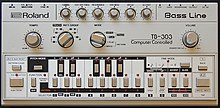Roland TB-303
| Roland TB-303 Bass Line | |
|---|---|
 TB-303 front panel | |
| Manufacturer | Roland |
| Dates | 1982-1984 |
| Price | £238 UK, $395 US |
| Technical specifications | |
| Polyphony | monophonic |
| Timbrality | monotimbral |
| Oscillator | Sawtooth and square wave |
| LFO | none |
| Synthesis type | Analog Subtractive |
| Filter | 24dB low pass resonant filter, non self oscillating |
| Aftertouch expression | No |
| Velocity expression | No |
| Storage memory | 64 patterns, 7 songs, 1 track |
| Effects | No internal effects. |
| Input/output | |
| Keyboard | No |
The Roland TB-303 Bass Line is a synthesizer released by the Roland Corporation in 1982. Designed to simulate bass guitars, it was a commercial failure and was discontinued in 1984. However, cheap second-hand units were adopted by electronic musicians, and its "squelching" or "chirping" sound became a foundation of electronic dance music genres such as house and techno. It has inspired numerous clones.
Features
The TB-303 was designed by Tadao Kikumoto, who also designed the Roland TR-909 drum machine.[1] It was marketed as a "computerised bass machine" to replace the bass guitar.[2] However, according to Forbes, it instead produces a "squelchy tone more reminiscent of a psychedelic mouth harp than a stringed instrument".[3]
The TB-303 has a single oscillator, which produces either a "buzzy" sawtooth wave or a "hollow-sounding" square wave.[3] This is fed into a 24dB[4] low-pass filter, which is manipulated by an envelope generator.[2] Users program notes and slides using a built-in sequencer.[3]
Impact and legacy
The 303's unrealistic sound made it unpopular with its target audience, musicians who wanted to replace bass guitars. It was discontinued in 1984,[5] and Roland sold off remaining units cheaply.[3]
The Chicago group Phuture bought a cheap 303 and began experimenting.[3][4] By manipulating the synthesizer as it played, they created a unique "squelching, resonant and liquid sound".[3] This became the foundation of "Acid Tracks", which was released in 1987 and created the acid genre.[3] Acid, with the 303 as a staple sound, became popular worldwide, particularly as part of the UK's emerging rave culture known as the second summer of love.[3][4]
"Rip It Up", by the Scottish post-punk band Orange Juice, which reached #8 in the UK singles chart in February 1983, was the first UK top 10 hit to feature the 303.[6] Another early use of a TB-303 (in conjunction with a TR-808 drum machine) is Indian musician Charanjit Singh's 1982 album Synthesizing: Ten Ragas to a Disco Beat. It remained obscure until the early 21st century, and is now recognized as a kind of proto-acid, though the originators of acid-house had never heard it..[7]
In the late 1980s and early 1990s, as new acid styles emerged, the TB-303 was often overdriven, producing a harsher sound, such as on Hardfloor's 1992 EP "Acperience" and Interlect 3000's 1993 EP "Volcano".[8] In other instances the TB-303 was distorted and processed, such as on Josh Wink's 1995 hit "Higher State of Consciousness".[4][9]
As only 10,000 303 units were manufactured, the popularity of acid caused a dramatic increase in the price of used units.[3] According to the Guardian, as of 2014, units sold for over £1,000.[10] In 2011, the Guardian listed the release of the TB-303 as one of the 50 key events in the history of dance music.[5] It has inspired numerous clones.[11] In 2014, Roland released the TB-3, a synthesizer emulating TB-303 circuitry.[12]
References
- ^ Hsieh, Christine. "Electronic Musician: Tadao Kikumoto". Retrieved 2010-10-02.
- ^ a b "The History Of Roland: Part 2 |". www.soundonsound.com. Retrieved 2018-03-26.
- ^ a b c d e f g h i Hamill, Jasper. "The world's most famous electronic instrument is back. Will anyone buy the reissued TB-303?". Forbes. Retrieved 2018-03-26.
- ^ a b c d "The Fall and Rise of the TB-303". Roland US.
- ^ a b Vine, Richard (2011-06-14). "Tadao Kikumoto invents the Roland TB-303". the Guardian. Retrieved 2018-03-26.
- ^ "Buzzcocks: Boredom / Orange Juice: Rip It Up - Seconds - Stylus Magazine". 2015-06-10. Archived from the original on 2011-06-04. Retrieved 2018-03-26.
{{cite web}}: CS1 maint: bot: original URL status unknown (link) - ^ Stuart Aitken (10 May 2011). "Charanjit Singh on how he invented acid house ... by mistake". The Guardian.
- ^ Church, Terry (Feb 9, 2010). "Black History Month: Jesse Saunders and house music". beat portal. Retrieved 16 October 2011.
- ^ "30 Years of Acid". Attack Magazine.
- ^ Reidy, Tess (2014-02-15). "Retro electronics still popular – but why not just use modern software?". the Guardian. Retrieved 2018-03-26.
- ^ Warwick, Oli (8 April 2017). "Attack of the clones: Is Behringer's Minimoog a synth replica too far?". Fact. Retrieved 30 November 2018.
- ^ "Roland Aira TB-3 review". 14 February 2014. Retrieved 13 November 2019.
Further reading
- "Roland TB-303 Bass Line". Electronics & Music Maker. April 1982. p. 20. OCLC 317187644.
- "Knowledge Base: The History of the Roland TB-303". Future Music. No. 262. February 2013. pp. 52–3. ISSN 0967-0378. OCLC 1032779031.

